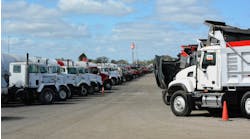We've previously discussed how keeping trucks in “trade terms” condition, especially at time of trade, can add value.
If done consistently, this will cultivate an image of quality for a fleet with used truck dealers. That in turn will create more desire by those dealers to acquire your fleet's equipment, which will of course further inch up your trucks' residual value compared to the trucks offered by other fleets.
Bear in mind that at the three-year point, The Truck Blue Book awards an additional $2,500 of value for a one-year wear out used-truck warranty; at four years, it adds $3,500.
Dive even deeper and you'll see the additional value a sound engine meeting the proper spec can bring, especially if it qualifies for an OEM or aftermarket used engine warranty.
In fact, retail used-truck buyers will pay more just knowing an engine has met the qualification of a used warranty. These may be sourced from an independent provider, such as National Truck Protection, an engine OEM, like the Cummins Encore Plus, Detroit Diesel P3 and Caterpillar Advantage programs, or a truck maker.
On top of that, operating day to day in a manner that enables the engine to meet a used truck warranty pays dividends on a daily basis — there's improved fuel economy, less downtime for major repairs, prompt handling of service bulletins, amortization of larger repairs over the life cycle of the truck, and improved reputation for trades at time of return.
Used engine warranties are similar enough that following a few suggestions will amount to passing a future warranty inspection.
First, test for engine performance (rated horsepower compared to wheel horsepower), which can be easily done on a dyno. The wheel horsepower should be no less than 80% of rated horsepower.
And while running on the dyno, test for blow-by. This gives an estimate of internal engine wear. Each engine OEM has its own standard, so please check.
Finally, do a coolant compression test. There should be no bubbles in the test bottle when the truck is operating under load. If bubbles are present, the most common reason is a failing or failed head gasket.
Also, review your ECM readings for any irregularities, fault codes or out of spec return of information. Address any issues with these items prior to trade.
It might be difficult to arrange time or locate a dyno so here are alternate suggestions for a comprehensive inspection, offered by Rick Clark of National Truck Protection.
Clark says to start with the engine cold, whenever possible. Tilt the hood and walk around the engine to look for oil, coolant leaks, rust stains and anything abnormal.
And while the engine is still cold, he suggests making the following inspections:
-
Remove the oil dipstick and check the oil level and viscosity.
-
Remove the oil filler cap and look for water contamination.
-
Check the coolant level.
-
Check the coolant condition for fuel and oil contamination.
-
Check the intake system for cracks and holes bypassing the air filter.
-
Check the exhaust system for cracks and broken studs.
-
Remove the intake hose nearest the turbocharger.
-
Check the turbocharger for oil, broken shaft, and fins hitting the housing.
-
Run the engine, listen for noise and check for visible smoke.
-
Do an ECM printout for engine serial number, total miles, rated horsepower, rated RPM and logged fault codes.
-
Make sure the engine serial number matches the ECM.
Because today's post-'02 engines operate hotter than pre-'02 engines, here are some additional items to check during the inspection: (1) cracking water hoses; (2) electrical wiring; (3) engine fan blades (should not be fatigued and cracked); (4) Engine belts and belt-tensioner pulley.
Take these extra steps and maintain your solid engine practices until the time of trade and you'll have a desirable piece of equipment that used-truck wholesalers will pay more for.


